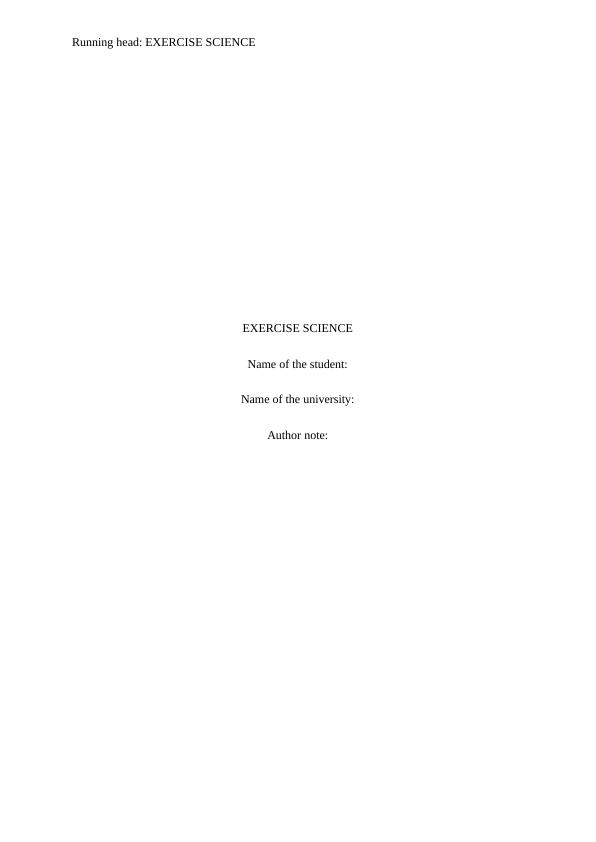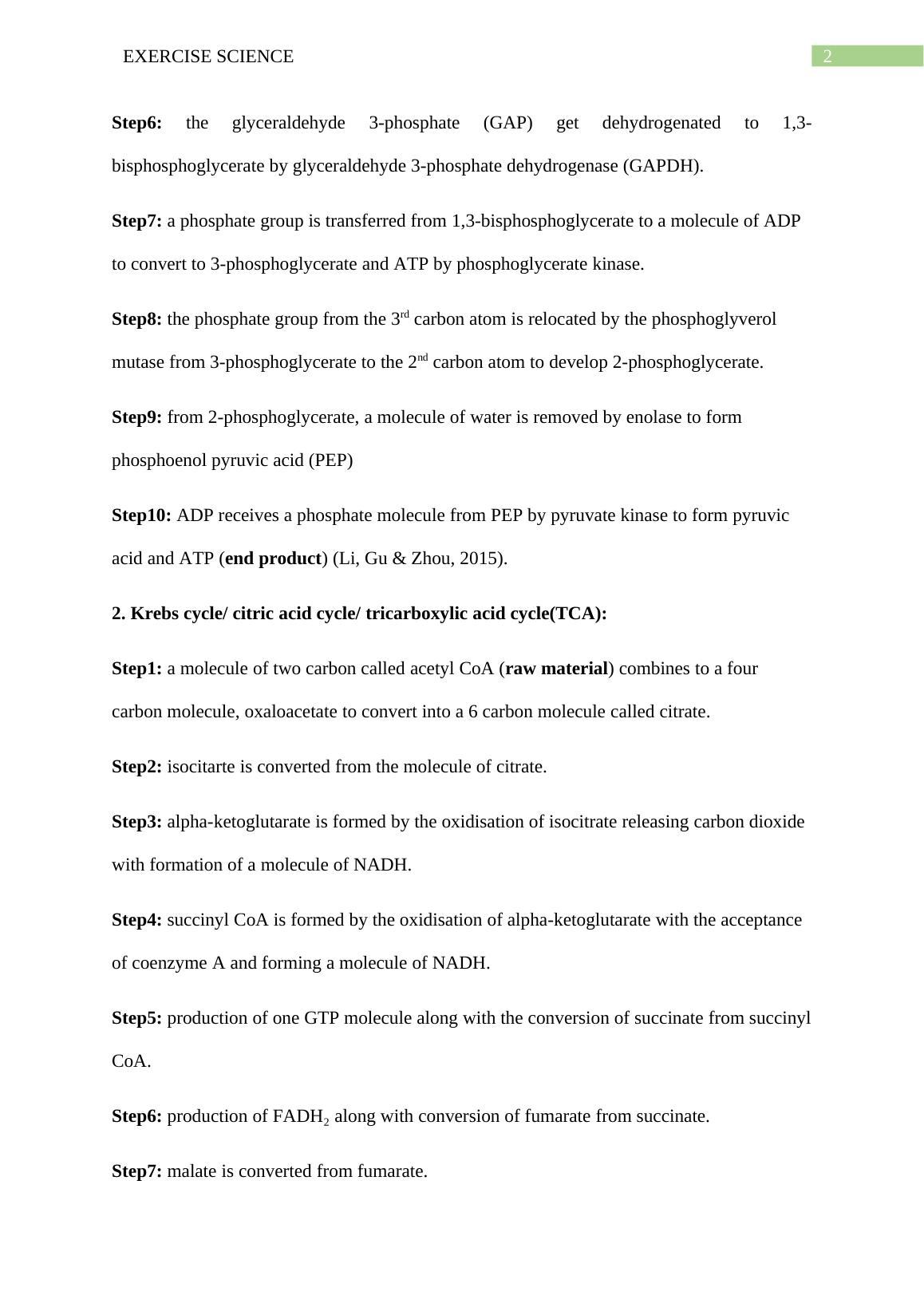Energy Processes in Exercise Science
Added on 2022-11-25
6 Pages1048 Words235 Views
Running head: EXERCISE SCIENCE
EXERCISE SCIENCE
Name of the student:
Name of the university:
Author note:
EXERCISE SCIENCE
Name of the student:
Name of the university:
Author note:

EXERCISE SCIENCE1
Identify the 3 main energy processes/cycles that the human body utilizes to produce
ATP from catabolizing 1 molecule of glucose.
The three main energy cycles or processes which the human body uses in order to produce
ATP from catabolizing each molecule of glucose are;
1. Glycolysis
2. Krebs cycle/ citric acid cycle/ tricarboxylic acid cycle(TCA)
3. Beta- oxidation (Bolte, Rensing & Maier, 2015).
Describe in great detail the “raw products” that go into each cycle as well as the
“end product” that comes out of each process
1. Glycolysis:
Steps of glycolysis:
Step1: conversion of D-glucose (raw material) to glucose-6-phosphate, catalysed by
hexokinase.
Step2: Phosphoglucose Isomerase rearranges glucose 6-phosphate (G6P) into fructose 6-
phosphate (F6P)
Step3: Fructose 1,6-bisphosphate in obtained from fructose 6-phosphate by
Phosphofructokinase consisting of magnesium as its cofactor.
Step4: Fructose 1,6-bisphosphate is divided into two molecules of sugars; dihydroxyacetone
phosphate(DHAP) and glyceraldehyde 3-phosphate (GAP) by the enzyme Aldolase.
Step5: the two sugar molecules DHAP and GAP is interchanged by Triophosphate isomerase
and a molecules of glyceraldehyde phosphate is detached and used in the further step of the
glycolysis process.
Identify the 3 main energy processes/cycles that the human body utilizes to produce
ATP from catabolizing 1 molecule of glucose.
The three main energy cycles or processes which the human body uses in order to produce
ATP from catabolizing each molecule of glucose are;
1. Glycolysis
2. Krebs cycle/ citric acid cycle/ tricarboxylic acid cycle(TCA)
3. Beta- oxidation (Bolte, Rensing & Maier, 2015).
Describe in great detail the “raw products” that go into each cycle as well as the
“end product” that comes out of each process
1. Glycolysis:
Steps of glycolysis:
Step1: conversion of D-glucose (raw material) to glucose-6-phosphate, catalysed by
hexokinase.
Step2: Phosphoglucose Isomerase rearranges glucose 6-phosphate (G6P) into fructose 6-
phosphate (F6P)
Step3: Fructose 1,6-bisphosphate in obtained from fructose 6-phosphate by
Phosphofructokinase consisting of magnesium as its cofactor.
Step4: Fructose 1,6-bisphosphate is divided into two molecules of sugars; dihydroxyacetone
phosphate(DHAP) and glyceraldehyde 3-phosphate (GAP) by the enzyme Aldolase.
Step5: the two sugar molecules DHAP and GAP is interchanged by Triophosphate isomerase
and a molecules of glyceraldehyde phosphate is detached and used in the further step of the
glycolysis process.

EXERCISE SCIENCE2
Step6: the glyceraldehyde 3-phosphate (GAP) get dehydrogenated to 1,3-
bisphosphoglycerate by glyceraldehyde 3-phosphate dehydrogenase (GAPDH).
Step7: a phosphate group is transferred from 1,3-bisphosphoglycerate to a molecule of ADP
to convert to 3-phosphoglycerate and ATP by phosphoglycerate kinase.
Step8: the phosphate group from the 3rd carbon atom is relocated by the phosphoglyverol
mutase from 3-phosphoglycerate to the 2nd carbon atom to develop 2-phosphoglycerate.
Step9: from 2-phosphoglycerate, a molecule of water is removed by enolase to form
phosphoenol pyruvic acid (PEP)
Step10: ADP receives a phosphate molecule from PEP by pyruvate kinase to form pyruvic
acid and ATP (end product) (Li, Gu & Zhou, 2015).
2. Krebs cycle/ citric acid cycle/ tricarboxylic acid cycle(TCA):
Step1: a molecule of two carbon called acetyl CoA (raw material) combines to a four
carbon molecule, oxaloacetate to convert into a 6 carbon molecule called citrate.
Step2: isocitarte is converted from the molecule of citrate.
Step3: alpha-ketoglutarate is formed by the oxidisation of isocitrate releasing carbon dioxide
with formation of a molecule of NADH.
Step4: succinyl CoA is formed by the oxidisation of alpha-ketoglutarate with the acceptance
of coenzyme A and forming a molecule of NADH.
Step5: production of one GTP molecule along with the conversion of succinate from succinyl
CoA.
Step6: production of FADH₂ along with conversion of fumarate from succinate.
Step7: malate is converted from fumarate.
Step6: the glyceraldehyde 3-phosphate (GAP) get dehydrogenated to 1,3-
bisphosphoglycerate by glyceraldehyde 3-phosphate dehydrogenase (GAPDH).
Step7: a phosphate group is transferred from 1,3-bisphosphoglycerate to a molecule of ADP
to convert to 3-phosphoglycerate and ATP by phosphoglycerate kinase.
Step8: the phosphate group from the 3rd carbon atom is relocated by the phosphoglyverol
mutase from 3-phosphoglycerate to the 2nd carbon atom to develop 2-phosphoglycerate.
Step9: from 2-phosphoglycerate, a molecule of water is removed by enolase to form
phosphoenol pyruvic acid (PEP)
Step10: ADP receives a phosphate molecule from PEP by pyruvate kinase to form pyruvic
acid and ATP (end product) (Li, Gu & Zhou, 2015).
2. Krebs cycle/ citric acid cycle/ tricarboxylic acid cycle(TCA):
Step1: a molecule of two carbon called acetyl CoA (raw material) combines to a four
carbon molecule, oxaloacetate to convert into a 6 carbon molecule called citrate.
Step2: isocitarte is converted from the molecule of citrate.
Step3: alpha-ketoglutarate is formed by the oxidisation of isocitrate releasing carbon dioxide
with formation of a molecule of NADH.
Step4: succinyl CoA is formed by the oxidisation of alpha-ketoglutarate with the acceptance
of coenzyme A and forming a molecule of NADH.
Step5: production of one GTP molecule along with the conversion of succinate from succinyl
CoA.
Step6: production of FADH₂ along with conversion of fumarate from succinate.
Step7: malate is converted from fumarate.

End of preview
Want to access all the pages? Upload your documents or become a member.
Related Documents
Process of Energy Production by Aerobic Respirationlg...
|10
|1727
|293
Assign. 1: Question 1 Surname, First Name. a).Glucose mlg...
|4
|2931
|28
Chemistry and Biochemistry – BIOB111lg...
|11
|1544
|260
